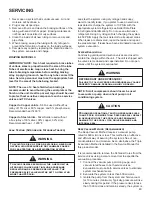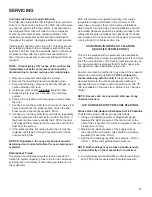
SERVICING
52
Checking Subcooling
Refrigerant liquid is considered subcooled when its
temperature is lower than the saturation temperature
corresponding to its pressure. The degree of subcooling
equals the degrees of temperature decrease below the
saturation temperature at the existing pressure.
1. Attach an accurate thermometer or preferably a
thermocouple type temperature tester to the liquid line
as it leaves the condensing unit.
2. Install a high side pressure gauge on the high side
(liquid) service valve at the front of the unit.
3. Record the gauge pressure and the temperature of the
line.
4.
Review the technical information manual or specification
sheet for the model being serviced to obtain the design
subcooling.
5. Compare the hi-pressure reading to the “Required
Liquid Line Temperature” chart (page 108). Find the hi-
pressure value on the left column. Follow that line right
to the column under the design subcooling value. Where
the two intersect is the required liquid line temperature.
Alternately you can convert the liquid line pressure
gauge reading to temperature by finding the gauge
reading in Temperature - Pressure Chart and reading to
the left, find the temperature in the °F. Column.
6.
The difference between the thermometer reading and
pressure to temperature conversion is the amount of
subcooling.
Add charge to raise subcooling. Recover charge to lower
subcooling.
Subcooling Formula = Sat. Liquid Temp. - Liquid Line
Temp.
EXAMPLE:
A. Liquid Line Pressure = 417
B. Corresponding Temp. °F. = 120°
C. Thermometer on Liquid line = 109°F.
To obtain the amount of subcooling subtract 109°F from
120°F.
The difference is 11° subcooling. See the specification
sheet or technical information manual for the design
subcooling range for your unit.
Checking Expansion Valve Operation
1. Remove the remote bulb of the expansion valve from
the suction line.
2. Start the system and cool the bulb in a container of
ice water, closing the valve. As you cool the bulb, the
suction pressure should fall and the suction temperature
will rise.
3. Next warm the bulb in your hand. As you warm the
bulb, the suction pressure should rise and the suction
temperature will fall.
4. If a temperature or pressure change is noticed, the
expansion valve is operating. If no change is noticed,
the valve is restricted, the power element is faulty, or
the equalizer tube is plugged.
5. Capture the charge, replace the valve and drier,
evacuate and recharge.
Summary of Contents for ASXC16
Page 4: ...PRODUCT IDENTIFICATION 4 ...
Page 5: ...PRODUCT IDENTIFICATION 5 ...
















































